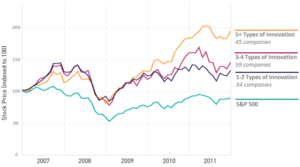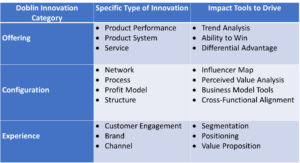
Marketing-Led Innovation (MLI) Reduces the Pressure to “Prove Marketing’s ROI”
Does your company put all its emphasis on product or service innovations? If so, it may be missing – or undervaluing – 8 other types of innovation that correlate highly to financial performance. And marketing can contribute significantly to all of them.
Companies That Pursue Multiple Types of Innovation Outperform Those That Don’t
According to the innovation consultancy Doblin, there are 10 types of innovation – 8 more categories beyond those of the product and service variety — that companies can pursue, across 3 categories;
- Offering (Product Performance, Product System)
- Configuration (Profit Model, Network, Structure, Process)
- Experience (Service, Channel, Brand, Customer Engagement).
Companies that are pursuing 5 or more types outperform those using fewer (see chart below).
Source: http://www.casact.org/education/leadership/CAS-Innovation.pdf
Are Your Marketing Contributions to Innovation Being Fully Valued?
We have observed that clients using our core tools in a disciplined and creative manner are investigating all 10 types of innovation – more than enough to drive the types of financial results shown above:
If your marketing plans have led to innovative approaches in some or all of these areas, then you are contributing more to company’s financial performance than is evident in prototypical marketing metrics.
To Fully Capitalize, Insist on Insights and “Gamify”
Of course, a company may be just going through the motions of creating a strategic marketing plan. Checking the boxes will not yield the types of creativity that excites customers and drives financial performance.
One of our latest approaches in our strategy workshops is to “gamify” (i.e., create a team vs. team competition) the process of uncovering deep insights when completing each piece of a plan. For example, teams are forced to articulate something new that they learned from building an influencer map, and are “graded” on the depth of their findings.
The competition that ensues drives teams to dig deeper and find better insights, which leads to more innovative strategies. For example, a team’s quest to find under-valued influencers may have led to an innovative channel strategy that is already improving the company’s results.
How One Client Redefined Innovation and Refreshed Their Entire Initiative
We recently worked with a commercial client whose creativity efforts were stagnating due to their own limited definition of innovation. They expanded their thinking to include initiatives around their “route to market” (via the Influencer Map). They also developed a creative segmentation that refreshed their product and service innovation list with some exciting initiatives.
But they were most excited about an innovation in how they charge for their services, using our business model tools. This approach will revolutionize the pricing method (e.g., the profit model) they’ve used for many decades.
How Marketing-Led Innovation (MLI) Reduces the Relentless Pressure to “Prove ROI”
We’ve coined the system that we used with this client and others “Marketing-Led Innovation” (MLI) because it’s broader than R&D-led innovation initiatives. We’ve seen how MLI is helping many companies re-energize by adding many market-focused ideas into the top of their innovation funnel.
In addition, the relentless pressure to “prove marketing’s ROI” is lessened considerably by MLI. The process highlights marketing’s contributions to creative initiatives that enthuse customers and investors — instead of focusing solely on the hard-to-measure payback from campaigns, social media investments, and the like.

 Tom Spitale
Tom Spitale

